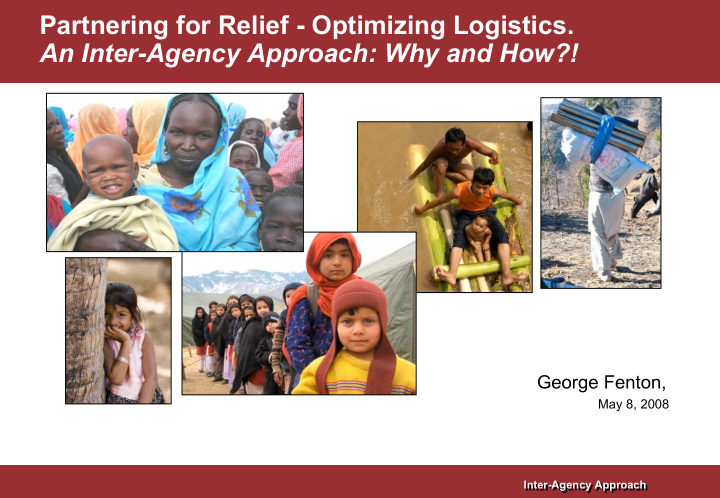



Partnering for Relief - Optimizing Logistics. An Inter-Agency Approach: Why and How?! George Fenton, May 8, 2008 Inter-Agency Approach Inter-Agency Approach
With the Global (natural) risk hotspots analysis of the World Bank, future emergency response needs can be assessed The World at Risk Mortality risk hotspots and top 20 recipients of humanitarian relief (1992-2003) Sources: Natural Disaster Hotspots Global Risk Analysis – IBRD/World Bank, University of Columbia, International Research Insitute for Climate prediction, Center for International Earth Science Information Network, Development Economics Research Group, Center for Hazards and Risk Research, Hazard Management Unit World Bank, International Center for Geohazzards, EM-DAT, CRED Inter-Agency Approach Inter-Agency Approach
While humanitarian needs are unpredictable there is an increasing trend of disasters Population growth in high risk areas & increasing frequency of disasters More historic data available Inter-Agency Approach Inter-Agency Approach
About $12 Bn / year spent on emergency response - largely government funded directly or via UN, NGO ’ s or Red Cross DONORS RELIEF AGENCIES ~ $7 Bn/yr - Bilateral ROUGH ESTIMATES ROUGH ESTIMATES ~ $3 Bn/yr Donor Government of Governments affected nation ~ $2 Bn/yr ~ $10 Bn/yr UN Affected Local NGO ’ s ~ $12 Bn/yr Population Corporations International NGO ’ s ~ $2 Bn/yr ~ $2 Bn/yr ~ $1 Bn/yr Red Cross Public in ICRC/IFRC/local donor countries Source: OECD – DAC, Global Humanitarian Assistance report, Good Humanitarian Donorship Project, Annual reports, interviews Inter-Agency Approach Inter-Agency Approach
Donor funding overall is still growing at 5% per year of which Africa remains the largest recipient Donor Funding of the Major Donors (members of the OECD Development Assistance Committee) 1995 -2003 ~5% growth p.a. Inter-Agency Approach Inter-Agency Approach
Main international relief agencies spend ~$600 Mn/yr on average on both emergency & development aid Top 20 Emergency Relief Agencies (>$ 95 Mn /yr) Emergency Relief Activities Top 20 Emergency Relief Agencies (>$ 95 Mn /yr) Emergency Relief Activities Food Shelter WASH Medical Food Shelter WASH Medical Program Expenses 2004 (Mn USD) 2900 WFP 1508 UNICEF 1400 WHO 1265 World Vision 1027 UNHCR 772 Save the Children Alliance 639 IOM 603 ICRC 588 Expenses of these CARE International organizations include 544 CRS grants to each other 522 MDM 402 Oxfam International 374 UNFPA 364 MSF 308 IFRC 179 Cordaid 147 IRC 142 UN Mercy Corps NGO 113 Concern Red Cross 95 OCHA Source: UN, NGO annual reports, interviews Inter-Agency Approach Inter-Agency Approach
Many parties involved in emergency response which poses serious challenges to the coordination and efficiency of aid DONORS RELIEF AGENCIES Government NL … UN World Bank FAO Japan UNFPA DGIS UNDP JICA EU UNHCR PUBLIC WFP UN-HABITAT OHCHR ECHO WHO IOM DFID UK Governments of UNJLC UNICEF affected nations Level of involvement OCHA DEC ICRC Local US USAID Red Cross Red Emergency Cross Response Local IFRC Red Crescent WEF TNT CARE SCHR IRC PRIVATE ICVA Booz Allen CRS Fritz MSF Institute Oxfam … SCA WVI Non Governmental Organization ’ s Corporations Inter-Agency Approach Inter-Agency Approach
The challenge is to increase efficiency (do more at less cost) and effectiveness (faster) of disaster responses Agencies increasingly see value in developing a concept called the Humanitarian Response Network (HRN) which could act as an information management hub. Inter-Agency Approach Inter-Agency Approach
The HRN would aim to….. – Improve response times to help more victims – Improve cost efficiency of the response to do more with the same funding – Reduce the complexity of the emergency response – Increase coordination between all stakeholders and support linkages with the corporate sector – Promote improved logistics preparedness and supplies pre-positioning opportunities Inter-Agency Approach Inter-Agency Approach
The Humanitarian Response Network would be able to make optimal use of each sector ’ s expertise Feedback mechanism on needs and situation Transportation Distribution Transportation Distribution Warehousing Warehousing Procurement & to affected Information Procurement & to affected Information & Planning & Planning Customs population Customs population Feedforward mechanism on stock and situation Corporate sector expertise UN Expertise UN Expertise NGO Expertise NGO Expertise Inter-Agency Approach Inter-Agency Approach
The advantages to pre-positioning relief supplies are: • Improvement of response times (<48 hours) – Direct access to relief goods / Faster access to airlift • Better coordinated logistics response mechanisms – Common first-wave pipeline for response (supply better fit to demand) – Limit number of organizations bringing in goods • Central access to up-to-date information – Central planning of logistics – Up-to-date information / common needs assessments • Access to funding – Access to CERF to pre-finance operations awaiting appeals – Access to free NFI (donated product) for first response Inter-Agency Approach Inter-Agency Approach
…as well as in cost efficiency • Low cost warehousing operations – Shared use of warehouse capacity / better stock turnover • Freight cost reductions – More efficient use of transport resources – Greater bargaining power • Better procurement of goods – Relief goods and support goods are procured in larger quantities leading to lower prices – Cost reductions due to standardization – Better conditions in Long Term Agreements – Possibilities for virtual stock and higher priority in times of scarcity Inter-Agency Approach Inter-Agency Approach
Proposed Organizational Structure The HRN would be a logistics preparedness � HRN HRN and response platform: There is a need for INGO groups to form � ERD ERD potential components of the HRN Location Location The UNHRD currently offers space in a � network of warehouses Each organization signs individual � MOU ’ s with UNHRD UNHRD MOU MOU ’ s UNHRD ’ s Governance Governance Inter-Agency Approach Inter-Agency Approach
Issues of Governance HRN HRN Five important procedures and protocols need to be established: ERD ERD – Decision-Making Procedure – Decision-Making Procedure Location Location – Procurement protocol – Procurement protocol – Cost Allocation protocol – Cost Allocation protocol MOU ’ ’ s UNHRD MOU UNHRD s – – Operations protocol Operations protocol – – Activation protocol Activation protocol Governance Governance Inter-Agency Approach Inter-Agency Approach
Recommend
More recommend